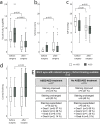Outcomes and complications of cataract surgery in patients with chronic ocular graft-versus-host-disease-a multicenter, retrospective analysis
- PMID: 35254513
- PMCID: PMC9325851
- DOI: 10.1007/s00417-022-05613-w
Outcomes and complications of cataract surgery in patients with chronic ocular graft-versus-host-disease-a multicenter, retrospective analysis
Abstract
Purpose: To evaluate the outcome of phacoemulsification in patients with chronic ocular Graft-versus-host disease (oGVHD) after allogeneic hematopoietic stem cell transplantation (aHSCT).
Methods: Retrospective, observational multicenter study from 1507 oGVHD patients. From the patient files, data were collected including best-corrected visual acuity (BCVA), intraocular pressure (IOP), Schirmer's test I, tear film break-up time (TFBUT), corneal fluorescein staining score, postoperative complications, and pre- and post-operative topical therapy.
Results: Seventy-three patients underwent cataract surgery in 104 eyes. In n = 84 eyes, the oGVHD NIH grade was documented; 12% (n = 12) of analyzed eyes were staged oGVHD NIH grade 1, 31% (n = 32) NIH 2 and 39% (n = 41) NIH 3. The mean BCVA improved in 82% of the eyes (n = 86 eyes). BCVA significantly increased from 0.7 ± 0.5 to 0.4 ± 0.4 LogMAR after surgery independent from oGVHD severity. The mean IOP decreased from 14 ± 4 to 13 ± 4 mmHg after surgery. Visual acuity was moderately correlated to the pre-operative degree of corneal staining (Pearson p = 0.26, p = 0.002, Cohen's effect size f = 0.29). The visual acuity decreased by 0.078 LogMar units (95% CI = 0.027-0.141) with each increase of corneal staining by one grade (p = 0.05). After surgery, corneal epitheliopathy increased significantly in 42% (n = 44) of the eyes. Postoperative complications included corneal perforation (n = 6, 6%), cystoid macular edema (n = 4, 4%), and endophthalmitis (n = 1, 1%).
Conclusion: Phacoemulsification in patients with chronic oGVHD significantly improves visual acuity, but is associated with an increased risk of complications in particular corneal epitheliopathy and corneal perforations.
Keywords: Cataract; Complication; Graft-versus-host-disease; Phacoemulsification.
© 2022. The Author(s).
Conflict of interest statement
P.S. has received financial support from Novaliq GmbH, Roche, Bausch&Lomb, and Ursapharm. All other authors declare no competing interests.
Figures



References
-
- Filipovich AH, Weisdorf D, Pavletic S, Socie G, Wingard JR, Lee SJ, Martin P, Chien J, Przepiorka D, Couriel D, Cowen EW, Dinndorf P, Farrell A, Hartzman R, Henslee-Downey J, Jacobsohn D, McDonald G, Mittleman B, Rizzo JD, Robinson M, Schubert M, Schultz K, Shulman H, Turner M, Vogelsang G, Flowers ME. National Institutes of Health consensus development project on criteria for clinical trials in chronic graft-versus-host disease: I. Diagnosis and staging working group report. Biol Blood Marrow Transplant. 2005;11:945–956. doi: 10.1016/j.bbmt.2005.09.004. - DOI - PubMed
Publication types
MeSH terms
Grants and funding
LinkOut - more resources
Full Text Sources
Medical

